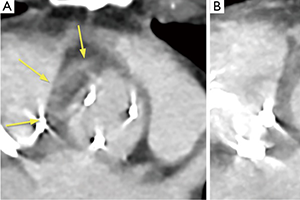Diagnostic tools in surgically treated patients with infective valve endocarditis
Abstract
Background: Infective valve endocarditis (IE) is associated with significant mortality and complication rates. The diagnosis impacts not only the prognosis but also the management of the disease. The aim of this article is to show the findings obtained from the implementation of our most important diagnostic tools and discuss our standard diagnostic process for patients with IE who underwent surgical treatment between 1994 and 2017.
Methods: Between December 1994 and January 2017 a total of 2,458 patients with IE underwent surgery at our institution. We analyzed clinical, microbiological, echocardiographic, and multi slice computer tomographic (MSCT) features in this group.
Results: The most often isolated involved valve was the aortic valve (59%). Prosthetic valve endocarditis (PVE) was present in almost one third of all cases. The most common valve failures were mitral valve insufficiency (MI) and aortic valve insufficiency (AI) (65% and 57% respectively). Almost one half of the aortic insufficiencies were severe. 63% of all vegetations assessed by echocardiography were larger than 1 cm. We detected a septic embolism in 44% of patients and the most common target organ was the spleen (25%). The most common isolated pathogen was Staphylococcus aureus (26%) and affected patients had a significant correlation with in-hospital mortality (P=0.004).
Conclusions: Echocardiography offers valuable information and is the most important diagnostic method in patients with IE. Preoperative MSCT contributes to the entire perioperative decision-making process. Microbiological diagnosis is mandatory in choosing and adjusting antibiotic therapy and also has prognostic value.
Cover






